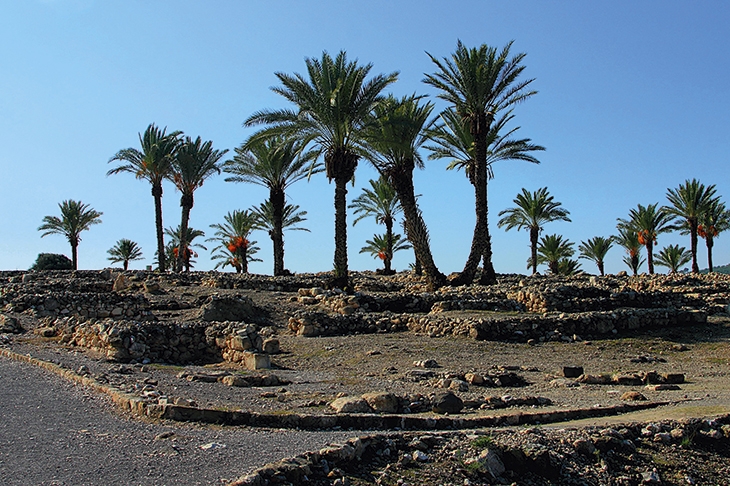Armageddon began as Har Megiddo, the Hill of Megiddo in northern Israel. The theological aspect is Christian. For Jews, ancient or modern, Megiddo is more existential than eschatological. The name denotes a fortress overlooking a strategic crossroads: Megiddo means ‘strength’. This is where the ancient Via Maris (the ‘way of the sea’, or coastal road) between Egypt and the Fertile Crescent cuts inland, through a pass from the Carmel mountains and into the Jezreel Valley. Megiddo remains strategically crucial and retains its potential for last stands. Today, the only airfield in Israel’s north, the erstwhile RAF base of Ramat David, sits somewhere in the valley (it’s not on maps, but its location is on Wikipedia).
Napoleon called the 11-mile wide valley ‘the most perfect battleground on the face of the earth’. In September 1918, Edmund Allenby prepared for the Allied Egyptian Expeditionary Force’s final battle with the Turks by studying the tactics of an earlier invader from Egypt. In 1479 BC, Pharaoh Thutmose III moved through the pass to defeat the Canaanites on the same ground; an inscription on a temple wall at Luxor records Thutmose’s opinion that capturing Megiddo was ‘like the capturing of 1,000 cities’. Allenby, having followed Thutmose’s chariot tracks through the pass and proceeded to Jerusalem, chose to be ennobled as Allenby of Megiddo. Naturally, everyone called him ‘Allenby of Armageddon’.
His source was Ancient Records of Egypt (1906), a multivolume collection edited by James Henry Breasted, the founder of the Oriental Institute at the University of Chicago. Digging Up Armageddon, by the accomplished American up-digger Eric Cline, is the story of how Breasted’s minions excavated Megiddo between 1925, when Breasted dispatched a crack team of four archaeologists to Mandate Palestine, and 1948, when Israeli troops, in one of the least dramatic Battles of Megiddo, took the hill from a local Arab militia without a fight. Like the best tales from the golden age of archaeology, Digging Up Armageddon combines the grandeur of ancient history, the currency of modern fame and the cast of a malarial soap opera.
The hill is man-made — the remains of at least 20 ancient cities dating from c. 5000 BC to just before 300 BC, stacked, Breasted said, ‘like a huge layer cake’. The strata are numbered by Roman numerals and, where necessary, subdivided into ‘A’ and ‘B’. Stratum XX, just above the bedrock, is the oldest, Neolithic settlement. Stratum I, offering sweeping views down the Jezreel Valley, is the newest, Persian layer. The strata in between date to the Copper, Bronze and Iron Ages: Canaanite, Israelite, Assyrian, Babylonian. Only two layers mattered to Breasted and his institute’s funder, John D. Rockefeller, Jr: the one captured by Thutmose III, and the one that, according to the Hebrew Bible, Solomon fortified as one of his ‘chariot cities’ in the tenth century BC. But where were they?
Led by Clarence Fisher, the Chicago team pitched its tents at the foot of the hill in April 1925. Fisher brought in ‘a body of trained workmen’ from the village of Quft in Egypt. The Quft workers had trained under Flinders Petrie and developed a ‘quasi-caste system’, with families providing hereditary overseers, pickmen and shovelmen. Working every season until 1939, they added to the apocrypha of Megiddo’s inhabitants eating Egyptian dates for breakfast, lunch and dinner — hence, according to locals, the date palms that now adorn the top of the mound. An early find in a spoil heap was an inscription from the Pharaoh Sheshonq (the ‘Shishak’, whom the Hebrew Bible describes as attacking Jerusalem c. 930 BC).
Trouble arrived in the archaeologists’ paradise in the form of the splendidly named P.L.O. Guy. The Mandate’s chief inspector of antiquities, Guy took a shovel to his colleagues’ reputations. He engineered the expulsion of Ruby Woodhead, the lone female secretary, for ‘intrigue, hintings and devious dealing’, as well as for being ‘infatuated’ with a teenage digger; and then the ‘unclean’ Fisher, who had brought a youth back to America from an earlier dig in Mesopotamia and who, Guy warned Breasted, should not be ‘in charge of young men’.
Guy got the glory of the big find in Stratum IV (before being fired himself in 1934), cabling Breasted in early June 1928:
‘FIRST KINGS FIFTEEN TO NINETEEN AND TEN TWENTY-SIX STOP STRATUM FOUR APPARENTLY CORRESPONDS STOP BELIEVE HAVE FOUND SOLOMON’S STABLES’
Breasted believed it too, and so did the papers. But were they really Solomon’s stables?
Cline excavated at Megiddo between 1994 and 2014 with the Solomon-skeptic Israel Finkelstein. A couple of years ago, I interviewed Cline about another dig in northern Israel, where his team had found massive wine cellars and ‘Minoan’-style frescoes. Careful then to avoid jumping to conclusions about the transmission of Minoan techniques, he is cautious here too. The ‘city of Solomon’ moniker now attaches to ‘at least four different levels at Megiddo’. Solomon’s stables became Ahab’s and now, Cline writes, are ‘possibly’ Jeroboam II’s. The stratum that Guy and Breasted attributed to Solomon ‘might actually be Jeroboam II’s’ and date from the eight century BC. Strata VA/IVB, a palace discovered below ‘Solomon’s stables’ in the 1960s by Yigael Yadin, is now dated later, to the time of Ahab and Omri in the ninth century BC.
Meanwhile, Finkelstein’s colleague David Ussishkin now suggests the ‘less than impressive’ stratum VB as Solomon’s city. But Cline, following Finkelstein, identifies the older ‘burnt mudbrick city’ in stratum VIA as possibly dating from the tenth century BC: the likeliest location ‘by default’. So far, however, neither the Megiddo conquered by Thutmose III nor the one built by Solomon has been firmly identified.
As a study in archaeological ambition and the limits of interpretation, Digging Up Armageddon is, as Cline writes of the Scottish theologian George Adam Smith’s Historical Geography of the Holy Land (1894), a ‘landmark publication in all senses of the word’.
This article was originally published in The Spectator’s UK magazine. Subscribe to the US edition here.


















